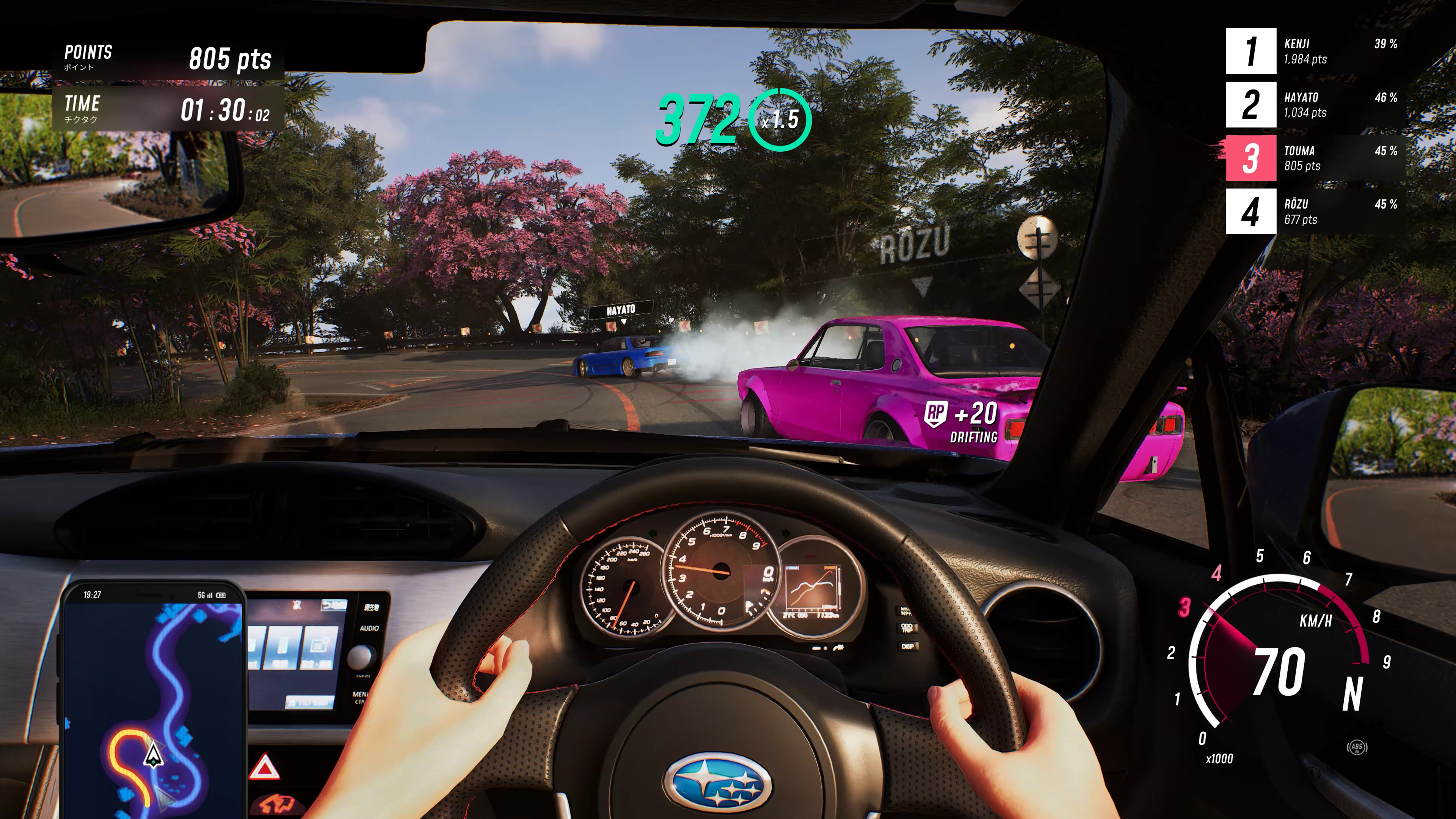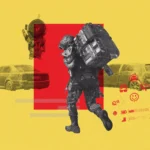Drifting culture finds its spiritual home in Japan, but the remarkable Bartosz Ostalowski hails from Poland. Despite losing both arms in an accident, Ostalowski became a professional drifter. He is uniquely the world’s only professional sports driver who steers with his foot.
Given this, it might seem incongruous that JDM: Japanese Drift Master was conceived and crafted in Central Europe. However, geographical distance clearly didn’t deter Warsaw-based developer Gaming Factory. They have created a reverent tribute to the Japanese art of turning corners sideways, emitting white smoke, and exuding coolness. JDM emerges as a commendable drift racer. It features a weighty yet approachable handling model, finely tuned for managing overzealous oversteer.
The game also boasts an excellent map, rich with eye-catching and authentic detail. Despite these strengths, it is currently hampered by a poor grip racing mode, inconsistent AI, and uneven difficulty. It feels somewhat like a project car that has been rushed onto the track before its final polish.
The Open World of JDM: Scale and Authentic Design
JDM: Japanese Drift Master offers an open-world racing experience set within a fictional, yet beautifully rendered, slice of Japan.
Map Size and Diverse Environments
The game’s world features approximately 250 kilometers of roads. These roads span a variety of environments, from dense city grids and elevated freeways to narrow, winding mountain passes and scenic, blossom-lined byways. While direct comparisons to giants like Test Drive Unlimited Solar Crown, The Crew Motorfest, or Forza Horizon 5 are difficult due to scale, JDM’s overall map is definitively smaller than these contemporaries.
A Compact Yet Victorious Map
Despite its more compact size compared to its open-world racing peers, JDM’s map does not suffer for it. In fact, its design may be its greatest triumph. The smaller scale allows for greater detail and intentionality in its layout.
“Cherry Good”: The Beauty and Challenge of JDM’s Roads
The visual splendor and realistic road design of JDM’s map are standout features, contributing significantly to its unique driving feel.
Aesthetic Appeal and Realistic Road Widths
At its most visually appealing, JDM’s map is truly a showstopper. Trees burst with vibrant pink blossoms, creating picturesque scenery. The quaint towns nestled around the central lake brim with character and charm, adding to the immersive Japanese atmosphere. However, the map’s primary strength lies in its commitment to more realistic road widths. This contrasts sharply with most other open-world racing games. Developers typically opt for wider streets to create more forgiving racing environments.
This makes overtaking and navigating civilian traffic easier. JDM, however, deviates from this philosophy. It leans towards narrower and more challenging roads, which often feel more akin to rally stages than traditional open-world racing circuits. Specific sequences of linked hairpin corners are a particular highlight, delivering a must-have experience for a drift-focused game. Gaming Factory has executed these sections impressively.
Pace and Perceived Speed on Narrow Roads
The cramped nature of the road network in JDM necessitates a different driving approach. Players must brake and carefully weave through and around oncoming traffic, rather than simply blazing up the center of wide lanes. This design technically reduces the overall average pace of the game. However, a highly effective sense of speed is maintained.
Thanks to the narrow roads, everything appears to whip by extremely quickly due to sheer proximity. At its core, JDM is an arcade racer, not a hardcore drift simulator. Yet, the challenge of patiently but assertively cutting through traffic and threading the car through tricky, tight gaps is enjoyable. This demanding but rewarding style of driving helps set JDM apart from its competitors.
Not All Roses: Current Frustrations and Technical Glitches
While the map and drift mechanics are strong, JDM currently suffers from several noticeable problems that impact the overall experience.
Inconsistent Traffic and Lighting
One notable issue is the sometimes excessive traffic density in the countryside. This feels disproportionate, especially considering the main city areas feel surprisingly deserted. Large, empty streets and very few moving cars make the urban environment less dynamic. At night, the lighting system also falters. Non-player character (NPC) headlights are significantly too dim. This causes oncoming cars to only become visible when they are almost upon the player, creating hazardous situations.
Regardless of the time of day, AI cars on highways exhibit an odd quirk. All traffic in front of the player automatically pulls to the left as the player approaches from behind, as if the player’s vehicle is an emergency vehicle with sirens blaring. This breaks immersion and makes the AI feel artificial.
Performance and Collision Detection
Performance has generally been acceptable on high-end systems (e.g., RTX 4080, Intel Core Ultra 9 185H). However, occasional detectable stuttering has been reported. Visually, the game appears more dependable with frame generation turned off and the frame rate capped at 60 FPS. Beyond performance, the game’s collision detection needs refinement. After extended playtime, it remains unclear which roadside objects are destructible and which are solid barriers.
Sometimes, large posts can be clattered through easily, while tiny obstacles bring the vehicle to an abrupt halt. It is generally advisable to avoid collisions altogether. JDM does not handle crashes well; minor bumps and jostling can cause cars to behave oddly, tilting and tossing in unnatural ways. While some of these issues are listed by Gaming Factory as known problems that may be addressed in future updates, they currently present active frustrations for players.
Gameplay Imbalance: Drifting vs. Grip Racing
A more significant systemic problem in JDM is its inconsistent difficulty, particularly when the game deviates from its core strength: drifting.
Drift Missions: Forgiving and Fun
The majority of JDM’s missions are appropriately drift-themed. This is undoubtedly for the best, as the handling model feels precisely built for drifting. The game offers two handling settings: arcade and simcade. Simcade provides a slightly more nuanced feel, possibly lacking some of the arcade mode’s soft assistance that helps keep cars stable during a drift. However, the overall difference between the two modes does not feel profoundly distinct. Drift missions encompass a variety of scenarios.
These range from sanctioned events on dedicated race tracks to humorous sushi delivery challenges, where larger tips are awarded based on how sideways the sushi gets en route. Score requirements for drift missions are generally forgiving, meaning players rarely need to repeat them. They offer a mostly light challenge, which is acceptable given the game’s arcade leanings.
Grip Racing: A Major Bottleneck
Frustratingly, JDM’s quality significantly falters whenever drifting is not the primary objective. The game’s implementation of grip racing is deeply unsatisfying. This proved to be a major bottleneck for progress during testing. AI opponents in grip races often drive directly into (and sometimes under) the player and other racers, acting as if the player’s car isn’t even present.
Attempting these races with a rear-wheel drive car is ill-advised. The AI simply accelerates away like slot cars, while the player struggles to gain drive out of corners. The recommendation is to acquire a cheap, front-wheel drive car, such as a Honda Civic, and apply whatever upgrades are available. The game offers no clear indication of the performance level of AI opponents’ cars in these races, forcing a trial-and-error approach.
Misleading Events and Limited Fast Travel
Compounding the frustration, JDM is not a great communicator regarding event types. There were instances where an upcoming task was marked as a drift event, but it turned out to be a race requiring the player to catch or escape an opponent. This is a significant “bait and switch,” as drift-tuned cars are highly impractical for such events.
While smoking up tires looks flashy, it’s not the quickest way to get from point A to point B. These events demand road-holding ability and quick corner exits. Hinting that a drift build is appropriate is a complete waste of time. It’s akin to asking someone to catch a professional basketball player on a freshly waxed court while wearing socks. To mitigate this, an all-wheel drive NSX was acquired, which easily outpaced the AI.
However, players often won’t realize they’ve brought a hopeless car to an event until they’ve driven to the location and been fundamentally outclassed. At that point, the only option is to quit, respawn at the nearest garage, select a new vehicle, and drive all the way back. JDM’s quick travel is limited to jumping between garages. While typically not bothered by driving to new events (as driving is the core enjoyment), this became grating in these specific instances of misleading event types.
Narrative, Car List, and Post-Game Content
JDM attempts to tie its events together with a unique narrative approach, features a respectable car list for an indie title, but currently has limited post-game content.
Manga-Inspired Storytelling
As a story-driven racer, JDM stitches all its events together using regular, manga-inspired graphic novel pages. These even read from right to left, consistent with Japanese manga. While this narrative style might not appeal to everyone (especially those unfamiliar with manga), it is undeniably a cute and on-brand way to inject extra personality into the game. Despite occasionally veering into cheesy and “hilariously horny” territory, it’s an admirable effort to provide a distinct narrative framework.
Licensed Cars and Deep Customization
Despite being an indie racer with a smaller budget, JDM’s garage boasts an impressive selection of just over 20 cars. Crucially, many of these are officially licensed. Iconic Japanese manufacturers such as Honda, Nissan, Mazda, and Subaru all make official appearances. This inclusion of licensed vehicles adds significant credibility to JDM’s overall love letter to drift culture.
Performance and interior/exterior customization are major features, with a vast array of parts to earn and install. This level of customization feels impressively akin to the Need for Speed series, particularly coming from a comparatively smaller developer. While some players might prefer understated builds, the option for flamboyant additions like a “katana gearstick” is readily available.
Limited End-Game and Future Promises
After the roughly 10-hour story concludes, the remaining content primarily involves collecting the remaining cars, dabbling with modifications, and cruising around solo. There are some sushi delivery side missions and “underground” drift events where players can bet on their projected scores, but the post-game offerings are currently limited. This lack of compelling end-game content means players might not feel a strong pull to continue playing long-term.
Gaming Factory has announced plans for more modes over the next nine months. These include an expanded driving school, additional missions, a dedicated photo mode, and even split-screen multiplayer (a significant feature, as there is currently no online multiplayer). However, the downside of these extensive future plans is that JDM feels somewhat unfinished at launch. It plays very much like an early access game, despite not being explicitly identified as such.
Verdict: A Promising Yet Unfinished Drift Experience
JDM: Japanese Drift Master is a hugely ambitious and earnest racing game. It clearly demonstrates a deep passion for the art of drifting, a passion shared by its intended audience. With its consistently gorgeous and intricately designed map, robust drift handling mechanics, and a mostly licensed car list, JDM redefines expectations for the scale achievable by indie developers in the racing genre.
However, while the experience of cruising and drifting is highly enjoyable, the game is undermined by several notable flaws. The unwelcome surprise events, which render drift-tuned cars impractical, and the poorly optimized grip racing mode, plagued by clumsy AI, detract significantly from the overall fun.
Developer Gaming Factory has promised numerous modes and fixes throughout the remainder of 2025 and beyond. Yet, this forward-looking development plan overtly leaves JDM feeling like an unfinished project. It has been shipped without the traditional “early access” caveat, creating a sense of an incomplete game at launch.








